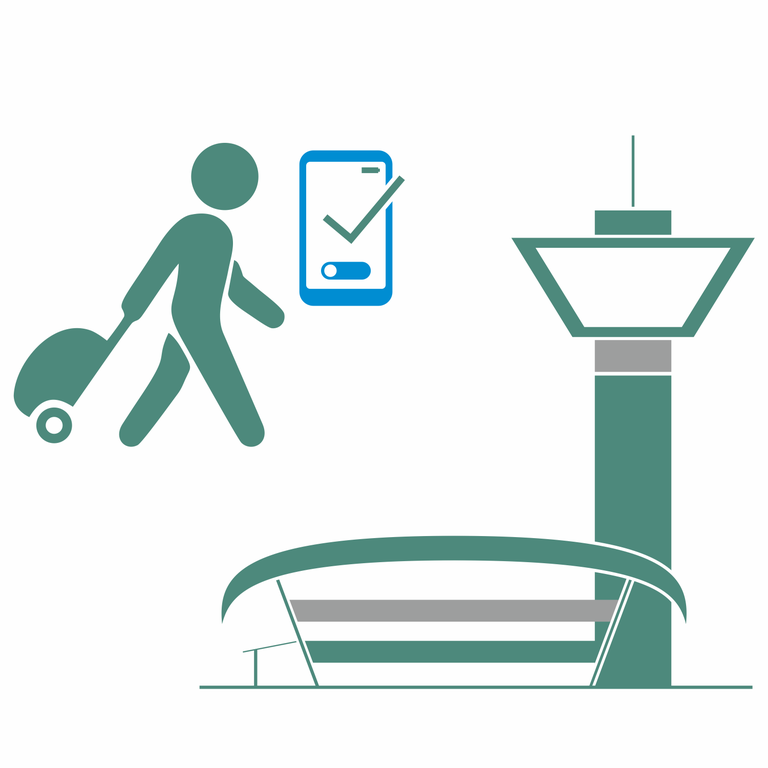Topics
Resource and gate assignment
Aircraft are handled on the airport apron and all necessary resources are allocated for the required operations. Deviations from the planned processes due to delays during the course of the day require constant adjustments to the initial planning, considering a multitude of constraints (e.g. departure slots, transfer passengers, restricted parking capacity on the apron). The objective of our research is to establish an application-oriented simulation environment in which a large number of operators is considered (e.g. apron traffic, ground handlers). In this way, optimized concepts can be tested directly in an interacting, virtual environment for their implementation capability. As with the landside processes, a large amount of data is to be generated if machine learning methods are to be used. Here, we set a focus on the aircraft turnaround, which is described by individual milestones (time stamps in the process) and is to be predicted using (un-) complete data.
Automated apron and upcoming technologies
The availability of advanced technologies enables processes to be increasingly automated. The airport, as a self-contained environment with well-defined access restrictions and simple traffic rules, is an ideal environment for incremental automation. First, however, a situational awareness of the airport must be generated by an appropriate sensor infrastructure. These sensors can be of various types and (a) part of the infrastructure, (b) integrated with the vehicle fleets, and (c) installed on the aircraft. For this purpose, an application-oriented simulation environment is being enhanced with synthetic sensors and integrated into a sensor framework. Since the data basis is a simulation (the position of all elements is known), investigations on the coverage and quality of the necessary sensor feedback can be conducted. Parallel to the integration of sensors, the effects of new technologies on the handling processes (e.g. use of electric vehicle fleets) are also investigated in our research.
Virtual Reality
Workplaces and environments of operators will gradually adapt to the possibilities of new technologies. Virtual reality is a key technology for obtaining extensive information about the system to be monitored, even remotely. However, virtual reality in this context does not refer to recreating a real environment; rather, it refers to providing and highlighting relevant information and elements. However, these must be derived from the available data and transformed into operator-appropriate information. For example, planned ground trajectories of aircraft could be superimposed to highlight critical intersection areas, or information could be provided regarding the turnaround sequence of each aircraft.
Real-time control of airport processes
To manage an airport, information from various areas (airside, landside) and from different system owners (e.g. airport, airline, air traffic control, handling services) must be combined. In an integrated management approach, decisions are made jointly while taking into account the respective target functions. From the observation of aircraft movements (ADS-B data), operational concepts can be derived and simple process predictions can be made without in-depth knowledge of the respective airport. The objective of research in this area is to create a data-sparse implementation of a simplified AOCC (Airport Operation Control Center) environment, which will be contrasted with representations of the actual environment during advanced development.
Technologies
- Creation of a virtual airport (airside) and mapping with process simulations of specific apron processes.
- Simulation of apron traffic (Anylogic) coupled with simulation of virtual sensors (BlAInder)
- Derivation of a situation picture from sensor feedback and matching with the virtual environment to identify technological requirements (coverage: quality vs. quantity)
- Model-based process simulation for training of data-driven AI solutions (model-supported data augmentation)
- Merging specific sensor simulation into a common platform for application-oriented concept implementation and future technologies evaluation
- Recording and processing of ADS-B data, real-time representation of airport operations
Publications (selected)
Data-driven airport management enabled by operational milestones derived from ADS-B messages
M Schultz, J Rosenow, X Olive (2022). Journal of Air Transport Management 99, 102164
Modeling Aircraft Departure at a Runway Using a Time-Varying Fluid Queue
E Itoh, M Mitici, M Schultz (2022). Aerospace 9 (3), 119
Synthetic Training of Neural Networks for Semantic Segmentation of LiDAR Point Clouds
M Schultz, S Reitmann, B Jung, S Alam (2022). International Workshop on ATM/CNS
Optimal Schedule Recovery for the Aircraft Gate Assignment with Constrained Resources
E Asadi, M Schultz, H Fricke (2021). Computers and Industrial Engineering 162, 107682
Agent-based simulation for aircraft stand operations to predict ground time using machine learning
M Luo, M Schultz, H Fricke, B Desart, F Herrema, RB Montes (2021). IEEE/AIAA 40th Digital Avionics Systems Conference (DASC), 1-8
Future aircraft turnaround operations considering post-pandemic requirements
M Schultz, J Evler, E Asadi, H Preis, H Fricke, CL Wu (2020). Journal of Air Transport Management 89, 101886
